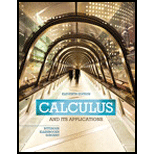
Concept explainers
Finding Natural Logarithms as Limits.
Given that the derivative of
Thus, we can define
In Exercises 54-57, use this definition to find each limit.
Want to see the full answer?
Check out a sample textbook solution
Chapter 3 Solutions
Calculus and Its Applications (11th Edition)
Additional Math Textbook Solutions
Thomas' Calculus: Early Transcendentals (14th Edition)
Precalculus (10th Edition)
Glencoe Math Accelerated, Student Edition
University Calculus: Early Transcendentals (4th Edition)
Calculus & Its Applications (14th Edition)
- Table 6 shows the population, in thousands, of harbor seals in the Wadden Sea over the years 1997 to 2012. a. Let x represent time in years starting with x=0 for the year 1997. Let y represent the number of seals in thousands. Use logistic regression to fit a model to these data. b. Use the model to predict the seal population for the year 2020. c. To the nearest whole number, what is the limiting value of this model?arrow_forwardDoes a Limiting Value Occur? A rocket ship is flying away from Earth at a constant velocity, and it continues on its course indefinitely. Let D(t) denote its distance from Earth after t years of travel. Do you expect that D has a limiting value?arrow_forwardThe formula for the amount A in an investmentaccount with a nominal interest rate r at any timet is given by A(t)=a(e)rt, where a is the amount ofprincipal initially deposited into an account thatcompounds continuously. Prove that the percentageof interest earned to principal at any time t can becalculated with the formula I(t)=ert1.arrow_forward
- Table 2 shows a recent graduate’s credit card balance each month after graduation. a. Use exponential regression to fit a model to these data. b. If spending continues at this rate, what will the graduate’s credit card debt be one year after graduating?arrow_forwardQuestion number 65arrow_forwardLet 60, 61. What is the derivative of the function y = log(x)? 1 -In(x) In(b) b* In(b) 1 In(b) X e* In(b)arrow_forward
- We can find the derivative of p by using the chain rule, but it will be simpler to first apply the properties of logarithms to rewrite the function as the difference of two logarithms. p = ln q2 − 6 q = ln − ln(q)arrow_forwardQuestion 2 If h(x) = f(g(x)) then W'(x) = f'(x)g'(x) True Falsearrow_forwardAre these done right?arrow_forward
 Functions and Change: A Modeling Approach to Coll...AlgebraISBN:9781337111348Author:Bruce Crauder, Benny Evans, Alan NoellPublisher:Cengage Learning
Functions and Change: A Modeling Approach to Coll...AlgebraISBN:9781337111348Author:Bruce Crauder, Benny Evans, Alan NoellPublisher:Cengage Learning
 College AlgebraAlgebraISBN:9781305115545Author:James Stewart, Lothar Redlin, Saleem WatsonPublisher:Cengage Learning
College AlgebraAlgebraISBN:9781305115545Author:James Stewart, Lothar Redlin, Saleem WatsonPublisher:Cengage Learning Linear Algebra: A Modern IntroductionAlgebraISBN:9781285463247Author:David PoolePublisher:Cengage LearningAlgebra & Trigonometry with Analytic GeometryAlgebraISBN:9781133382119Author:SwokowskiPublisher:Cengage
Linear Algebra: A Modern IntroductionAlgebraISBN:9781285463247Author:David PoolePublisher:Cengage LearningAlgebra & Trigonometry with Analytic GeometryAlgebraISBN:9781133382119Author:SwokowskiPublisher:Cengage




